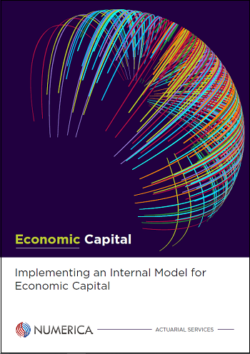
Topics such as risk-neutral probability and market-consistent valuation are at the heart of a Risk-Based Capital or an Economic Capital (EC) framework. Yet they continue to remain widely misunderstood. As the insurance regulations continue to evolve, it is important to get a proper grasp of some of these concepts.
Here is a list of five topics that are essential to understand in today’s regulatory and business landscape.
1. Market-consistent valuation
Usually referred in the context of valuation of policyholder liabilities, this topic should become easier to relate to, if we take valuation of assets as an example.
Consider a bond (bond 1), issued by a corporation and listed on a stock exchange. At any point in time, it has a price at which it can be bought or sold; i.e. market price. If an insurer holds this bond, it will be valued at its market price.
Consider another bond (bond 2), issued by the same corporation, but not listed on any stock exchange. If an insurer holds this bond, they cannot value this bond directly from the market, as the market price is unknown, since the bond is not listed. But what is known, is the amount and frequency of coupons, maturity date and several other features, which can all be used in constructing the cashflows that bond will provide in the future.
An insurer can then calculate the NPV of these cashflows as a ‘proxy’ to the market value. If the discount rate to calculate the NPV is set to the prevailing market interest rate (risk-free rate), the NPV will be the ‘market-consistent’ value of bond 2.
Similar to an unlisted bond, the liabilities of insurance companies represent a set of cashflows and are not listed. So insurers need to come up with ‘market consistent’ assumptions to discount those cashflows and the resulting NPV will be the market-consistent value of liabilities.
2. Risk-neutral probability
Let’s refer to the example of bond 1 from the previous point. The bond provides contractual cashflows, but there is a chance that the issuer could default and the holder of the bond will receive less than the contractual cashflows. Let’s just assume that if the issuer defaults, the holder of the bond will receive nothing.
The market value of this bond reflects this probability of default. If the NPV of the contractual cashflows discounted at the prevailing interest rates is 100, then the market value could be slightly lower, say 95. This means that the market has assigned an ‘implied’ probability of default, say q, which can be back-calculated by adjusting the cashflows so that the NPV using the risk free rate, equals 95. Without going into mathematics, let’s just assume that we calculated q to be 1%.
Probabilities implied by market prices are referred to as risk-neutral probabilities. This probability measure ensures that the expected return from any security is just equal to the risk-free return and that the riskiness of a security produces no excess (expected) return. Therefore, the market valuation is ‘risk-neutral’.
Risk-neutral probabilities are back-calculated from the market prices of the traded instruments. For example:
| Risk parameter | Type of security |
| Equity volatility | Equity call or put options |
| Interest rate volatility | Swaptions |
| Probability of default | Corporate bonds, Credit Defaut Swaps (CDS) |
3. Real-world probability
Let’s refer back to the example of the corporate bond above. One can always conduct an analysis of historical defaults on bonds similar to the bond in question. The default rate ‘p’ derived from historical analysis will be the ‘real-world’ probability.
In all likelihood, p will be lower than q, the risk-neutral probability, because the market tends to over-estimate the probability of default as the investors demand compensation to take on the risk. This is true for other financial securities as well; the probability of any adverse event that affect the cashflows from a security will be over-estimated if markets are ‘efficient’.
4. Real-world vs. risk-neutral probabilities
Most actuarial analyses, such as Economic Capital or MCEV, require a projection of probability-adjusted cashflows from insurance policies. As explained in the previous two points, there are two sets of probability measures that are used in the projection of these cashflows.
Whether you would use the real-world or risk-neutral probability measure, will depend on the objective of the projection. There is one important principle to understand:
Only when the purpose is to come up with a market valuation of policies (i.e. market-consistent value of liabilities), one would need to use risk-neutral probabilities.
In all other cases, you would generally use real-world probabilities.
Here are a few examples:
| Purpose | Probability measure |
| Estimating Time Value of Guarantees (TVoG) | Risk-neutral |
| Business planning | Real-world |
| Economic Capital assessment | Real-world |
| Valuation of options | Risk-neutral |
| Own Risk and Solvency Assessment (ORSA) | Real-world |
| Technical Provisions | Risk-neutral |
| Pricing of options | Depends on the risk appetite of the insurer |
5. Risk margin
Risk margin is an important component of a realistic balance sheet (or an Economic Capital balance sheet) and forms part of Technical Provisions. It is also closely connected to the topics of market-consistency and risk-neutrality and that’s why has been introduced here.
Solvency II prescribes the cost-of-capital method for calculating risk margin. In the past, another method, the percentile method was also common which seems to have lost favour now. It can be debated which method is the best, but that’s not the objective of introducing risk margin here. Instead, the focus is on how the concepts discussed above create a need for calculating the risk margin.
An insurer’s balance sheet is drawn up using market or market-consistent valuations. Market-consistent valuation can be done for financial risks, such as equity return and interest rates, because it is easy to find traded securities that can hedge these risks (these are hedgeable risks). On the contrary, there is no deep market for securities which hedge other risks facing an insurer such as mortality and persistency risks (these are ‘non-hedgeable’ risks).
When valuing an insurer’s liabilities, it is common to take a ‘best-estimate’ view of these risks. This ‘Best-Estimate Liability’ or BEL, reflects risk-neutral probabilities of financial risks, and real-world probabilities of non-financial risks. Therefore, BEL by itself is not fully market-consistent.
Market requires risk-neutral probabilities for all uncertain events, which are usually more adverse than real-world probabilities. Therefore, a ‘margin’ is required to the best-estimate assumptions that were made in BEL calculation, which reflects the difference between real-world and risk-neutral probabilities for the same risks. This risk margin along with the BEL should reflect the market-consistent value of the liabilities.
The view expressed here are my own and do not constitute a professional advice. If you agree, disagree or have a question, feel free to leave a comment below.
Implementing an Internal Model for Economic Capital. Download by clicking the picture below:
Other publications can be accessed here.


January 29, 2018 at 10:17 am, Actuarial valuation of pension liability in corporate transactions • Numerica said:
[…] In case of pension schemes, the liability is not listed on a capital market. Therefore, a fair value has to be derived. This calls for a special actuarial valuation, which aims to replicate the market value of pension scheme liabilities. Such a valuation is called a market-consistent valuation. You can get more information about these valuations here. […]